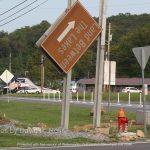Here is an LBL sign and wild hog update.
Lots of things seem upside down when it comes to Land Between the Lakes. Signs hang wrong and wild pigs hang around in the wrong place.
The LBL sign is fixed now and it didn’t hang upside down long. The wild hogs of LBL is another matter
WILD HOG UPDATE FROM USDA NEWS RELEASE
In 2014, in response to the increasing damage and disease threats posed by expanding feral swine populations in the United States, Congress appropriated $20 million to the United States Department of Agriculture’s Animal and Plant Health Inspection Service (APHIS) for the creation of a collaborative, national feral swine damage management program, according to a USDA news release.
The overarching goal of the APHIS National Feral Swine Damage Management Program is to protect agricultural and natural resources, property, animal health, and human health and safety by managing damage caused by feral swine in the United States and its territories. To accomplish this goal, APHIS is working in cooperation with states, tribes, other federal agencies, universities, organizations, the public, and other stakeholders, the release said.
APHIS also collaborates with Canada and Mexico to support border activities and facilitate an informational exchange on feral swine disease monitoring and control activities.
Since environmental conditions and laws governing feral swine vary considerably among states, APHIS’ strategy is to provide resources and expertise at a national level, while allowing flexibility to manage operational activities from a local or state perspective. The overall objective of the program is to minimize damage inflicted by feral swine. APHIS implements activities to reduce problems associated with feral swine in most states where they are present.
In states where feral swine are emerging or populations are low, APHIS cooperates with local and state agencies to implement strategies to eliminate them. APHIS also targets feral swine emerging in urban areas where they pose a danger to people and property. APHIS uses an integrated approach to feral swine damage management issues, incorporating the latest scientific research findings, improvements in field tactics, and communication and outreach tools to accomplish its goal.
More specifically, APHIS has developed the following objectives with regard to feral swine damage management:
- Stabilize and eventually reduce the range and size of feral swine populations in the United States and territories in accordance with management objectives of states, territories and tribes.
- Further develop cooperative partnerships with other pertinent federal, state, territorial, tribal, and local agencies, and private organizations working to reduce impacts of feral swine to agriculture, natural resources, property, animal health, and human health.
- Expand feral swine management programs nationwide to protect agriculture, natural resources, property, animal health, and human health.
- Monitor feral swine for pathogens that affect domestic swine, other livestock, and human health.
- Develop and improve tools and methods to manage feral swine populations, including field tests to assess the efficacy for reducing risks to agriculture, natural resources, property, animal health, and human health.
- Develop predictive models for population expansion and economic impacts of feral swine, along with risk analyses to agriculture, animal health, and human health.
- Develop outreach materials and activities to educate the public about feral swine damage and related activities to prevent or reduce damage.
- Coordinate with Canada and Mexico to establish a collaborative plan to address the feral swine threat along the common borders, including monitoring, research and operational responses as appropriate.
This page is currently under construction. Please check in soon for more!


